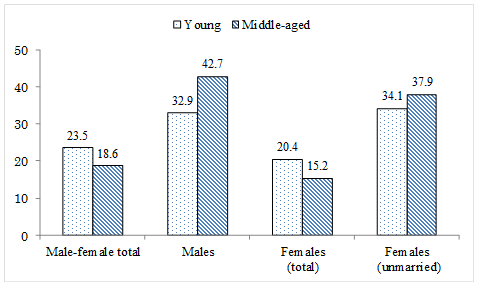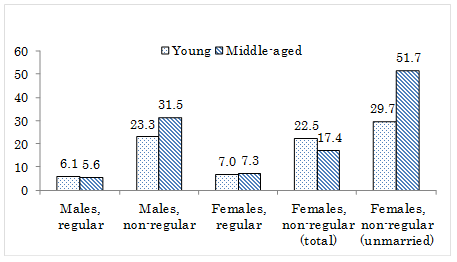JILPT Research Report No.164
Research on the Work and Lives of Middle-aged (35-44) Non-Regular Workers:
Analysis of present situation
May 12, 2014
Summary
Research Objective
Now that more than 20 years have passed since the increase in young non-regular workers became problematic, and those who first graduated from school in the period known as the "employment ice age" approach the age of 40, non-regular workers in the 35-44 age bracket are increasing. The number of these workers has doubled in the last 10 years from approximately a half million in 2002 to one million in 2012, even excluding married women.
This study focuses on non-regular workers in the 35-44 age bracket (hereinafter referred to as "middle-aged non-regular workers") in contradistinction to young non-regular workers in the 25-34 age bracket, and aims to clarify (1) the reasons why they end up in non-regular employment, (2) the present situation of their work and lives, and (3) the conditions needed for them to improve their careers from the current situation.
Research Method
For this study, the authors conducted an interview survey with 25 males and females including middle-aged non-regular workers in FY2012, and gathered hypothetical information on (1), (2) and (3) mentioned above as a result (see Research Material Series No.126 (only in Japanese)).
Based on these hypothetical findings, in July-August 2013 the authors conducted a nationwide “Questionnaire survey on vocational careers and ways of working”, featuring a combination of Life History Calendars (LHC) and normal questionnaires. The survey was aimed at 10,000 persons aged 25-44 across the nation (3,000 aged 25-34, 7,000 aged 35-44), and 4,970 valid responses were received (valid response rate 49.7%).
This report sets out to analyze the present situation of the work and lives of middle-aged non-regular workers based on the nationwide questionnaire survey, mainly through comparison with young non-regular workers and middle-aged regular workers.
Analysis of the reasons why these workers end up in non-regular employment and of the conditions needed for them to improve their careers is due to be carried out from FY 2014 onwards, which will also be based on a nationwide questionnaire survey.
Major Findings
In this report, the authors analyze the current status of middle-aged non-regular workers, in terms of their employment and work condition, annual income, living situation, state of health, work consciousness and behavior, as well as gender differences in each of these aspects. The results are as follows.
- Excluding married women, middle-aged non-regular workers often choose non-regular employment for more negative reasons than young non-regular workers do (Figure 1). Also, unlike regular workers, their job duties do not grow more advanced as they move from younger years to middle age, and their wages and annual salaries tend not to rise, despite being their family’s breadwinners in many cases. As a result, they are more prone to fall into poverty (Figure 2) and are less satisfied with their lives than young non-regular workers are. In addition, partly due to their age, they often have health problems.
- The analysis revealed that receiving vocational training (Off-JT) leads to an increase in the wages of non-regular workers. It also showed that their wages are higher if there is a system for converting their status to regular workers and that non-regular workers employed by companies with such systems are more likely to have hope for the future and goals in their working lives. These effects are not limited to young non-regular workers, but may also be identified among middle-aged non-regular workers.
- Middle-aged non-regular workers are more satisfied with their lives if their employment contract is open-ended. They also engage in skills development more actively if there are pay raises.
- Middle-aged non-regular workers in specialized or technical jobs, or service jobs that require qualifications, are engaged in relatively high-quality employment compared to other non-regular workers, in that the job level is higher, training is well-developed, and wages or annual salaries are higher. Moreover, being assigned “tasks requiring specialized knowledge or skills” has the effect of encouraging skill development activity by middle-aged non-regular workers.
Figure 1. Ratios of involuntary non-regular workers (%)

Note: The figure shows the ratios of non-regular workers who cited “Because there was no company where I could work as a regular worker” as the reason why they chose their current employment status. (From the annexed spreadsheet in main report)
Figure 2. Poverty ratios of regular and non-regular workers (*) (%)

Note: Figures indicate the ratio of workers whose equivalent household incomes are below the half of the median value for equivalent household incomes of employed workers.
*The poverty ratio here is calculated using a different method from that published by the Ministry of Health, Labour and Welfare. (See main report p.149, Figs. 5-2-3 and 5-2-4)
Policy Implications
The necessary policy directions based on the above analysis may be enumerated as follows.
- Judging from the scale of hardship faced, and the fact that this arises through a disparity between regular and non-regular employment in the labor market, middle-aged non-regular workers should also be subject to labor policies as with young non-regular workers.
- Supporting companies which promote skill development for non-regular workers and establish systems to convert to regular workers could be an effective policy not only for young non-regular workers but also for middle-aged non-regular workers.
- However, in places where middle-aged non-regular workers are employed, training is not as advanced as in those where young non-regular workers are, and systems for conversion to regular worker have not been introduced. Thus, it is important to stabilize the lives of these workers by introducing open-ended employment contract and pay raises, and to create a positive cycle that will lead to advantages for the company as well, through their improved skills. However, care should be taken when demanding these measures from companies, in that the actual state of introduction and practice differs depending on corporate scale. Specifically, systems of pay raises tend to be introduced more by larger companies, so it is important to promote introduction, in particular, by small and medium-sized enterprises; conversely, open-ended employment contract tends to be more prevalent in small and medium-sized enterprises, making it particularly important to promote diffusion among large corporations.
- Conversions to specialized/semi-specialized occupations (specialized or technical jobs, or service jobs that require qualifications) need to be promoted. Of course, converting to these job types in itself does not necessarily make it easier to convert to regular employment, nevertheless, it is thought that promoting a conversion to these specialized/semi-specialized types of job through public vocational training could be a realistic and effective policy in terms of lightening the hardships faced by middle-aged non-regular workers.
Policy Contribution
As well as stressing the importance of making middle-aged non-regular workers subject to labor policy, this study has proposed necessary policy directions from the standpoint of evidence-based policy Research.
Contents
-
Cover – Preface – Authors – Contents
-
Part I Analysis
-
Part II Survey data
Research Categories
Project Research “Research on Strategic Labor/Employment Policies for Non-regular Workers”
Subtheme “Survey Research on diverse ways of working in both regular and non-regular employment”
Research Period
FY2013
Authors
- Koji TAKAHASHI
- Researcher, Japan Institute for Labour Policy and Training
- Haruhiko HORI
- Vice Senior Researcher, Japan Institute for Labour Policy and Training
- Yasutaka FUKUI
- Project Researcher, Institute of Social Science, University of Tokyo
- Qingya LEE
- Assistant Fellow, Japan Institute for Labour Policy and Training
- Tomohiko MORIYAMA
- Assistant Professor, Department of Sociology, Doshisha University
- Shingou IKEDA
- Vice Senior Researcher, Japan Institute for Labour Policy and Training

